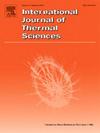长方体纳米结构对固液界面局部热阻分布影响的分子动力学研究
IF 4.9
2区 工程技术
Q1 ENGINEERING, MECHANICAL
International Journal of Thermal Sciences
Pub Date : 2025-05-01
DOI:10.1016/j.ijthermalsci.2025.109949
引用次数: 0
摘要
本文主要研究了不同长方体纳米结构体系在固液界面的热传递。我们以0.2 nm的空间分辨率计算了固液界面热阻(ITR)和局部ITR的分布。结果采用非平衡分子动力学方法得到。应用热电路模型,结合局部热阻计算热阻。此外,我们还引入了光谱分析来解释局部ITR震级的分布。结果表明,纳米结构的局部itr在顶端减小,而在底部增大。顶角的热输运对固液界面的总热输运有显著贡献。结果表明,只有当界面周围局部温度跳变接近,即固液相互作用强度不是很高时,整体ITR与结合局部ITR的比值与平面面积与沿下壁面积的比值一致,且纳米结构包括Cassie-Baxter状态。此外,从固体原子的光谱分析中,我们发现纳米结构的上角固体原子的振动态密度(VDOS)和光谱热通量在低频范围内达到峰值,并且在所有情况下,上角的VDOS重叠都变得更高。这种强烈的振动耦合是导致纳米结构上角局部ITR最低的另一个因素。本文章由计算机程序翻译,如有差异,请以英文原文为准。

Molecular dynamics study on the effects of cuboid nanostructure on the distribution of local thermal resistance at a solid–liquid interface
This study focuses on thermal transport at the interface between solid and liquid with various cuboid nanostructure systems. We calculated the solid–liquid interfacial thermal resistance (ITR) and the distribution of local ITRs with a 0.2 nm spatial resolution. The results were obtained using non–equilibrium molecular dynamics. Applying a thermal circuit model, we computed the thermal resistance by combining the local ITRs. Also, we introduced spectral analysis to explain the distribution of local ITR magnitudes. As a result, we found that the local ITRs decreased at the top corner of the nanostructure and increased at its base. The thermal transport at the top corner contributed significantly to the total thermal transport at the solid–liquid interface. It was revealed that the ratio of the overall ITR to the combined local ITRs agreed with the ratio of the area of a flat surface to the area along the lower wall and the nanostructure, including the Cassie–Baxter state, only when the local temperature jumps around the interface are closely similar i.e. the interaction strength between solid and liquid is not extremely high. Moreover, from spectral analysis of solid atoms, we found that the vibrational density of states (VDOS) and the spectral heat flux of the solid atoms at the top corner of the nanostructure peaked in a low–frequency range and the VDOS overlap became higher at the top corner in all cases. This strong vibrational coupling is another factor contributing to the lowest local ITR at the top corner of the nanostructure.
求助全文
通过发布文献求助,成功后即可免费获取论文全文。
去求助
来源期刊

International Journal of Thermal Sciences
工程技术-工程:机械
CiteScore
8.10
自引率
11.10%
发文量
531
审稿时长
55 days
期刊介绍:
The International Journal of Thermal Sciences is a journal devoted to the publication of fundamental studies on the physics of transfer processes in general, with an emphasis on thermal aspects and also applied research on various processes, energy systems and the environment. Articles are published in English and French, and are subject to peer review.
The fundamental subjects considered within the scope of the journal are:
* Heat and relevant mass transfer at all scales (nano, micro and macro) and in all types of material (heterogeneous, composites, biological,...) and fluid flow
* Forced, natural or mixed convection in reactive or non-reactive media
* Single or multi–phase fluid flow with or without phase change
* Near–and far–field radiative heat transfer
* Combined modes of heat transfer in complex systems (for example, plasmas, biological, geological,...)
* Multiscale modelling
The applied research topics include:
* Heat exchangers, heat pipes, cooling processes
* Transport phenomena taking place in industrial processes (chemical, food and agricultural, metallurgical, space and aeronautical, automobile industries)
* Nano–and micro–technology for energy, space, biosystems and devices
* Heat transport analysis in advanced systems
* Impact of energy–related processes on environment, and emerging energy systems
The study of thermophysical properties of materials and fluids, thermal measurement techniques, inverse methods, and the developments of experimental methods are within the scope of the International Journal of Thermal Sciences which also covers the modelling, and numerical methods applied to thermal transfer.
 求助内容:
求助内容: 应助结果提醒方式:
应助结果提醒方式:


